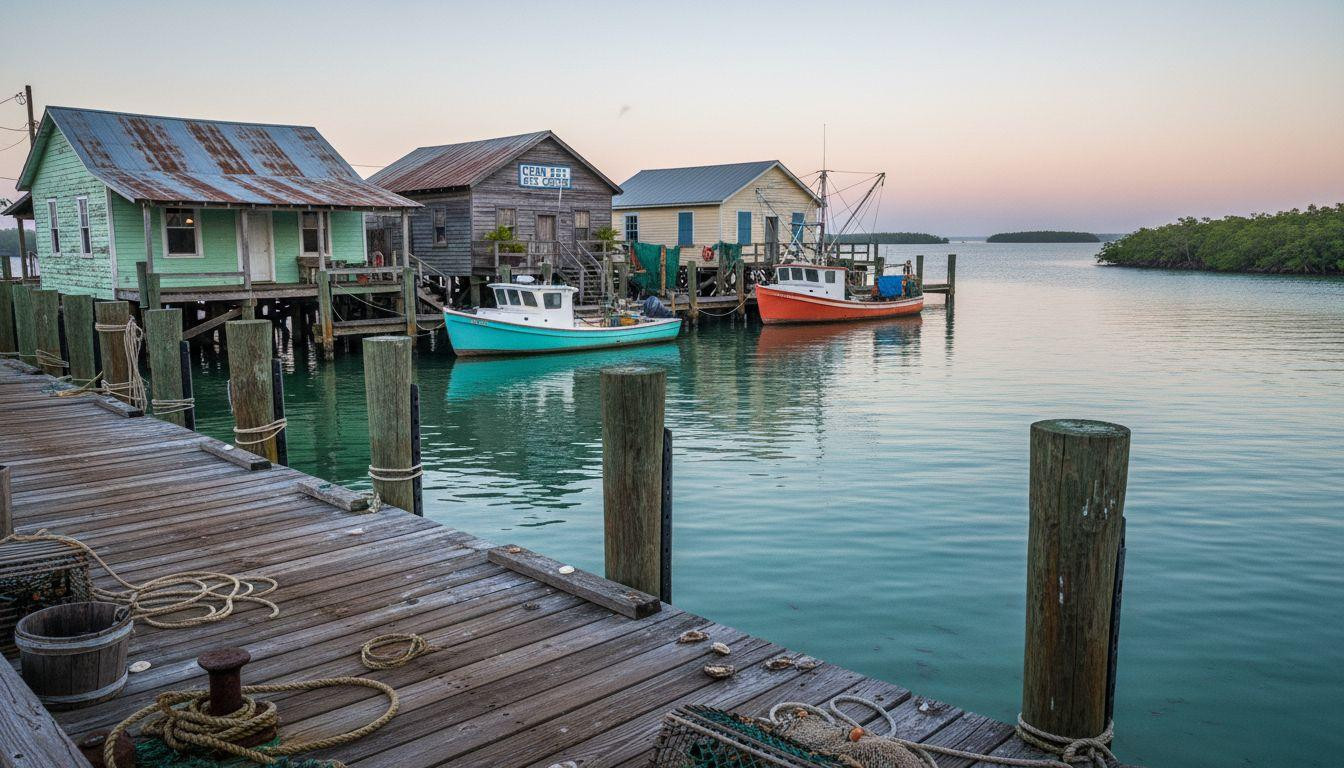Morning fog drifts across weathered wooden planks where working shrimp boats dock at dawn. Cedar Key’s historic wharf emerges from the mist like a forgotten chapter of Florida’s Gulf Coast story. While resort towers crowd Sanibel Island 120 miles south, this cluster of small islands maintains the quiet rhythm that made Florida coastal towns legendary.
The difference hits you at 6 AM when fishing boats return with their catch. Salt air carries the sound of rigging and hushed conversations between fishermen unloading clams and grouper. This authentic maritime scene disappeared from most Gulf destinations decades ago.
Sanibel’s crowds versus Cedar Key’s quiet
Sanibel Island welcomes 2.7 million visitors annually, charging $35 for causeway access and $300-500 nightly resort rates. Hotel occupancy dropped from 80% to 50% following Hurricane Ian recovery efforts, yet crowds still pack popular beaches during peak season. Conservation efforts preserved natural areas but couldn’t prevent commercial development.
Cedar Key receives just 30,000 annual visitors across its 1.4 square miles. The 700 permanent residents maintain fishing traditions dating to the mid-1800s when the town prospered as a lumber and seafood shipping hub. No causeway tolls, no high-rises, no chain restaurants disturb the island’s National Register Historic District designation.
November temperatures average 73°F highs and 60°F lows with minimal rainfall. Morning fog creates atmospheric photography conditions that attract artists and photographers seeking moody Gulf Coast imagery unavailable at manicured resort destinations.
The artist community that chose authenticity
Working studios in weathered buildings
The Cedar Key Arts Center anchors a creative community of painters, sculptors, and craftspeople. Galleries occupy reclaimed storefronts and low-rise buildings along the historic waterfront. Seasonal art walks present evening itineraries of studio visits, live music, and conversations between artists and visitors.
Working artists live above their studios or in modest cottages within walking distance of the wharf. Sea-inspired paintings, wood carvings, and handmade jewelry reflect the island’s maritime character rather than tourist stereotypes. Monthly artist residencies attract creative visitors seeking peaceful work environments far from urban distractions.
Culture instead of commerce
Local restaurants keep menus focused on harvested clams, grouper, shrimp, and oysters caught by island fishermen. Meal prices range $12-18 for casual dining and $20-35 for specialty seafood preparations. The annual Cedar Key Clam Festival celebrates harvesting traditions with food, crafts, and music events during spring months.
Accommodations include basic inns starting at $90 nightly, coastal hotels averaging $130-180, and vacation rentals rarely exceeding $200 during peak season. These authentic lodging options preserve small-town character while welcoming travelers seeking genuine coastal experiences.
Experiencing Florida’s working waterfront
Dawn at the docks
Fishing boats approach the harbor before sunrise as soft gray light illuminates weathered structures. The sound of diesel engines mingles with seabird calls and gentle water lapping against wooden pilings. Fishermen unload fresh catches while early visitors witness authentic maritime routines unchanged for generations.
Guided kayak tours navigate calm estuary waters through mangrove-lined channels. Tour costs range $50-100 per person depending on duration and wildlife viewing opportunities. The quiet island cluster provides ideal conditions for observing dolphins, herons, and other coastal species in their natural habitat.
Island flavors and traditions
Clam harvesting remains an active industry supporting local restaurants and festivals. Cedar Key claims the title “Clam Capital of Florida” with annual shucking championships drawing regional participants. Fresh seafood appears on menus within hours of being caught, creating farm-to-table experiences without pretension or premium pricing.
Local historians note the town’s evolution from industrial shipping hub to artistic retreat reflects conscious community choices. Residents actively preserve the unhurried pace and neighborly interactions that define island life. This commitment to authenticity attracts visitors seeking experiences beyond standardized resort offerings.
When Florida islands remember their roots
November mornings reveal Cedar Key at its most atmospheric. Fog softens the harsh edges of modern tourism, creating timeless scenes of boats, water, and weathered wood. Artists set up easels along the wharf capturing light conditions impossible to find at developed destinations.
The island’s modest scale invites walking exploration rather than driving between attractions. Historic buildings house working businesses instead of tourist shops selling imported souvenirs. Real fishing boats outnumber pleasure craft, maintaining the working waterfront character that originally defined Gulf Coast communities.
Your Questions About Cedar Key answered
How do I reach Cedar Key from major cities?
Drive 120 miles north from Tampa (2.5 hours) or 70 miles from Gainesville (90 minutes) via State Road 24. Gainesville Regional Airport serves regional flights while Tampa and Orlando airports provide international connections. No public transportation serves the island, making personal vehicles necessary for access.
What makes Cedar Key different from other Florida islands?
Cedar Key maintains active fishing industries and working waterfront character lost at tourist-focused destinations. The artist community lives and works on the island year-round rather than serving seasonal visitors. Fog and quiet mornings create atmospheric conditions rare in developed coastal areas.
When should I visit for the best experience?
November through April offers mild temperatures (60-75°F), minimal rainfall, and atmospheric fog conditions. Summer brings heat and humidity but fewer crowds than any season at popular beach destinations. Spring coincides with the Clam Festival and peak artist community activity.
Cedar Key’s fog-wrapped mornings preserve the Gulf Coast authenticity that resort development erased elsewhere. Working boats emerge from silver mist carrying the day’s fresh catch while artists capture light impossible to find at commercialized destinations.
